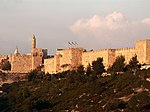Yehud (province)

Yehud, also known as Yehud Medinata or Yehud Medinta (lit. 'Province of Judah'), was an administrative province of the Achaemenid Persian Empire in the region of Judea that functioned as a self-governing region under its local Jewish population. The province was a part of the Persian satrapy of Eber-Nari, and continued to exist for two centuries until its incorporation into the Hellenistic empires following the conquests of Alexander the Great. The area of Persian Yehud corresponded to the previous Babylonian province of Yehud, which was formed after the fall of the Kingdom of Judah, the southern Israelite kingdom that had existed in the region prior to the Jewish–Babylonian War and subsequent Babylonian captivity. It had a considerably smaller population than that of the fallen kingdom. Yehud Medinata was the Aramaic-language name of the province, which was first introduced by the Babylonians during their governance of the same region prior to the Persian conquest in 539 BCE.
Excerpt from the Wikipedia article Yehud (province) (License: CC BY-SA 3.0, Authors, Images).Yehud (province)
Agripas, Jerusalem Nahlaot
Geographical coordinates (GPS) Address Nearby Places Show on map
Geographical coordinates (GPS)
| Latitude | Longitude |
|---|---|
| N 31.783333333333 ° | E 35.216666666667 ° |
Address
Agripas 8
9422904 Jerusalem, Nahlaot
Jerusalem District, Israel
Open on Google Maps








